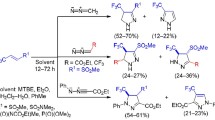Abstract
The regioselective acylation of 2-methylindole (2) with acyclic di- and trialkoxycarbenium tetrafluoroborates1 produces, by way of the stable indolyl-alkoxycarbenium ions4, the 3-acylated indoles5a–5c, and the 3-methoxy-carbonylindole5d. The ambident electrophilic cations1 all react as a1-electrophiles with the very nucleophilic indole2. In the reaction of2 with trimethoxycarbenium tetrafluoroborate (2d) methylated products are formed additionally.
Zusammenfassung
Die regioselektive Acylierung von 2-Methylindol (2) mit acyclischen Di- und Trialkoxycarbenium-tetrafluoroboraten1 liefert über die stabilen Indolyl-alkoxycarbenium-Ionen4 die 3-acylierten Indole5a–5c und das 3-Methoxycarbonylindol5d. Die ambidenten elektrophilen Kationen1 reagieren gegenüber dem gut nukleophilen Indol2 bevorzugt als a1-Elektrophil. In der Reaktion von2 mit dem Trimethoxycarbenium-tetrafluoroborat1d werden zusätzlich auch methylierte Produkte gebildet.
Similar content being viewed by others
References
Part VI:Pfeuffer L., Müller J., Pindur U., Chimia39, 143 (1985).
Kutney J. P., Total Synthesis of Natural Products (ApSimon J., ed.), Vol. 3. New York: Wiley-Interscience. 1977.
Saxton J. E. (ed.), Indoles, Part Four. New York: Wiley-Interscience. 1983.
Livingstone R., Rodd's Chemistry of Carbon Compounds, Vol. IV, Suppl. A (Ansell M. F., ed.), p. 428. Amsterdam-Oxford-New York-Tokyo: Elsevier. 1984.
Hünig S., Angew. Chem.76, 400 (1967);Gompper R., Regioselectivity in Reactions of Ambident Anions and Cations, in Chem. Future, Proc. IUPAC Congr., 29th 1983 (Grünewald H., ed.), p. 193–198. Oxford: Pergamon. 1984.
Akgün E., Pindur U., Müller J., J. Heterocyclic Chemistry20, 1303 (1983).
Müller J., Pindur U., Arch. Pharm. (Weinheim)317, 555 (1984).
Pindur U., Müller J., Chem. Ztg.108, 150 (1984).
Pindur U., Müller J., Chimia39, 141 (1985).
Dorofeenko G. N., Mezheritskaya L. V., Vasserman A. L., Zh. Obshch. Khim.41, 731 (1971); Chem. Abstr.75, 35591 u (1971).
Meerwein H., Bodenbrenner K., Borner P., Kunert F., Wunderlich K., Justus Liebigs Ann. Chem.632, 38 (1960).
Gerlach A., Dissertation, Universität Marburg, 1969.
For an excellent review about di- and trialkoxycarbenium ions:Perst H., Oxonium Ions in Organic Chemistry. Weinheim-New York: Verlag Chemie, Academic Press. 1971.
Taft R. W., Martin R. H., Lampe F. W., J. Amer. Chem. Soc.87, 2490 (1965);Holmes J. L., Lossing F. P., Can. J. Chem.60, 2365 (1982);Burt R. A., Chambers C. A., Chiang Y., Hillock C. S., Kresge A. J., Larsen J. W., J. Org. Chem.49, 2622 (1984).
Richter A. M., Fanghänel E., Tetrahedron Lett.24, 3577 (1983).
Borch R. F., J. Chem. Soc. Chem. Commun.1968, 442;Borch R. F., J. Org. Chem.34, 627 (1969).
Kabuß S., Angew. Chem.78, 714 (1966).
Dimroth K., Heinrich P., Angew. Chem.78, 714 (1966).
Gund P., J. Chem. Educ.49, 100 (1972);West R., Nin J., Nonbenzoid Aromatics (Snyder J. P., ed.). New York: Academic Press. 1969.
Noland W. E., Venkiteswaran M. R., Richards C. G., J. Org. Chem.26, 4241 (1961);Cook A. H., Majer J. R., J. Chem. Soc.1944, 486.
Remers W. A., Indoles Part One (Houlihan W. J., ed.). New York-London: Wiley-Interscience. 1972; and references cited therein.
Akgün E., Pindur U., Monatsh. Chem.115, 587 (1984).
Author information
Authors and Affiliations
Rights and permissions
About this article
Cite this article
Pindur, U., Flo, C. Regioselective, mild acylation of 2-methylindole with di- and trialkoxycarbenium tetrafluoroborates—A simple procedure for deriving 3-acyl-2-methyl-indoles and 3-methoxycarbonyl-2-methylindole. Monatsh Chem 117, 375–383 (1986). https://doi.org/10.1007/BF00816532
Received:
Accepted:
Issue Date:
DOI: https://doi.org/10.1007/BF00816532




